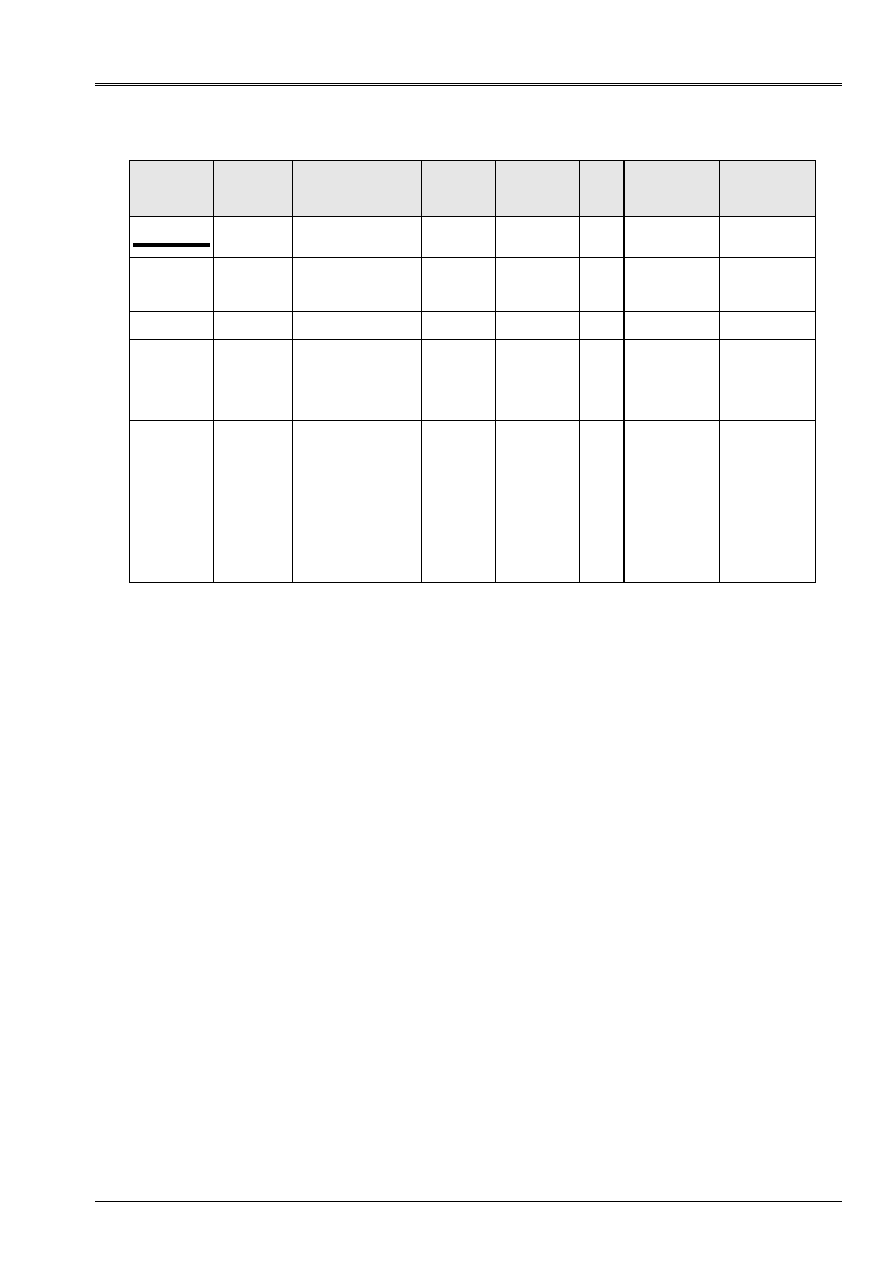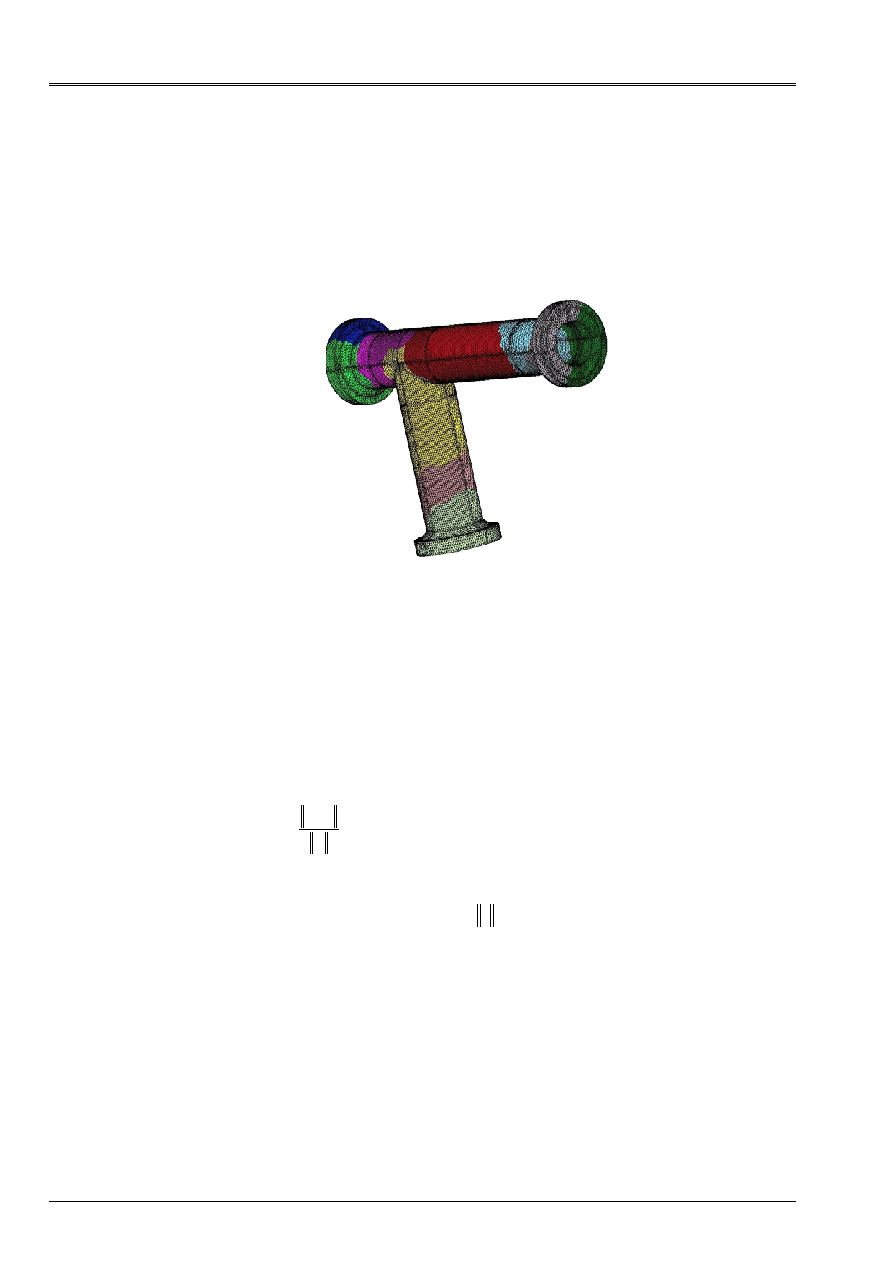
Code_Aster
®
Version
8.2
Titrate:
Key word
SOLVEUR
Date:
31/01/06
Author (S):
J. PELLET, O. BOITEAU
Key
:
U4.50.01-F1
Page:
1/14
Instruction manual
U4.5- booklet: Methods of resolution
HT-62/06/004/A
Organization (S):
EDF-R & D/AMA, SINETICS
Instruction manual
U4.5- booklet: Methods of resolution
Document: U4.50.01
Key word
SOLVEUR
1 Goal
To choose the mode of storage of the matrices and the algorithm of resolution. This key word factor is found
in a certain number of controls leading to the resolution of linear systems. For
algorithms of resolution it makes it possible to choose between “conventional” factorization of type “GAUSS”
(
“LDLT”
), multi-frontal factorization (
“MULT_FRONT”
or
“MUMPS”
), combined gradient
packaged ILU (K) (
“GCPC”
) or solvor FETI by decomposition of fields (
“FETI”
).
For each type of solvor, certain optional numerical parameters are accessible and are
described here. By defect, it is the solvor
“MULT_FRONT”
who is used. Solvor “FETI”, as for him, is
still in phase of development, it is thus not advised to use it without preliminary consultings
of the team of development.

Code_Aster
®
Version
8.2
Titrate:
Key word
SOLVEUR
Date:
31/01/06
Author (S):
J. PELLET, O. BOITEAU
Key
:
U4.50.01-F1
Page:
2/14
Instruction manual
U4.5- booklet: Methods of resolution
HT-62/06/004/A
2 Syntax
SOLVEUR = _F (
# “Multi-frontal” Factorization of the type:
/
METHOD
=
“MULT_FRONT”
,
[DEFECT]
#
Numerical parameter
RENUM
=
/
“MONGREL”
,
[DEFECT]
/“MANDELEVIUM”,
/“MDA”,
#
Functional parameters
STOP_SINGULIER =/“YES”, [DEFECT]
/
“NOT”
,
NPREC
=
/
8
,
[DEFECT]
/
nprec
,
[I]
# Factorization “conventional” of Gauss type:
/
METHOD
=
“LDLT”,
#
Numerical parameter
RENUM
=
/
“RCMK”
,
[DEFECT]
/
“WITHOUT”
,
#
Functional parameters
STOP_SINGULIER =/“YES”, [DEFECT]
/
“NOT”
,
NPREC
=
/
8
,
[DEFECT]
/
nprec
,
[I]
# “Multi-frontal” Factorization of the type with MUMPS:
/
METHOD
=
“MUMPS”,
TYPE_RESOL =/“CAR”
, [DEFECT]
/
“NONSYM”
,
/
“SYMGEN”
,
/
“SYMDEF”
,
RESI_RELA
=
/
10
- 6
,
[DEFECT]
/
resi
,
[R]
PCENT_PIVOT
=
/
20,
[DEFECT]
/
pcpiv,
[R]
# Iterative Method of the combined gradient:
/
METHOD
=
“GCPC”,
#
Numerical parameters
PRE_COND
=
“LDLT_INC”
,
[DEFECT]
NIVE_REMPLISSAGE
=/
0
,
[DEFECT]
/
niv
,
#
Functional parameters
NMAX_ITER
=
/
0
,
[DEFECT]
/
niter,
[I]
RESI_RELA
=
/
10
- 6
,
[DEFECT]
/
resi
,
[R]

Code_Aster
®
Version
8.2
Titrate:
Key word
SOLVEUR
Date:
31/01/06
Author (S):
J. PELLET, O. BOITEAU
Key
:
U4.50.01-F1
Page:
3/14
Instruction manual
U4.5- booklet: Methods of resolution
HT-62/06/004/A
# Method of decomposition of fields FETI:
/
METHOD
=
“FETI”,
#
Functional parameters
PARTITION
=
sdfeti
NMAX_ITER
=
/
0
,
[DEFECT]
/
niter,
[I]
RESI_RELA
=
/
10
- 6
,
[DEFECT]
/
resi
,
[R]
#
Parameters of the problem of interface
PRE_COND
=
/
`
LUMPE'
, [DEFECT]
/“WITHOUT”,
SCALING =
/
“MULT”
,
[DEFECT]
/
“WITHOUT”
,
TYPE_REORTHO_DD=
/
“GSM”,
[DEFECT]
/
“GS”
,
/
“IGSM”
,
/
“WITHOUT”
,
NB_REORTHO_DD
=/
0
,
[DEFECT]
/
nb_reortho,
[I]
#
Parameters of the local problems
RENUM
=
/
“MONGREL”
,
[DEFECT]
/“MANDELEVIUM”,
/“MDA”,
STOP_SINGULIER =/“YES”, [DEFECT]
/
“NOT”
,
NPREC
=
/
8
,
[DEFECT]
/
nprec
,
[I]
#
Parameters of tests, various
VERIF_SDFETI
=
/“YES”
,
[DEFECT]
/“NOT”
,
TEST_CONTINU
=/10
- 6
,
[DEFECT]
/
test_continu,
[R]
STOCKAGE_GI
=
/“CAL”
,
[DEFECT]
/“YES”,
/“NOT”,
INFO_FETI
=
/“FF”,
[DEFECT]
/info_feti,
[K9]
#
Parameter for parallelism
NB_SD_PROC0 =/
0
,
[DEFECT]
/
nb_sdproc0,
[I]
#
Parameter for accelerations (problem of the multiples type second members)
ACCELERATION_SM
=
/“YES”
,
[DEFECT]
/“NOT”
,
NB_REORTHO_INST
=
/0
,
[DEFECT]
/
nb_reortho_inst,
[I]
#
Parameter common to all the solveurs
SYME =
/
“NOT”
,
[DEFECT]
/
“YES”,
),

Code_Aster
®
Version
8.2
Titrate:
Key word
SOLVEUR
Date:
31/01/06
Author (S):
J. PELLET, O. BOITEAU
Key
:
U4.50.01-F1
Page:
4/14
Instruction manual
U4.5- booklet: Methods of resolution
HT-62/06/004/A
3 Operands
3.1 Operand
METHOD
METHOD =
This key word makes it possible to choose the method of resolution of the linear systems:
/“MULT_FRONT”
(defect)
Direct Solvor of type “multi-frontal”. Matric storage is
“MORSE”
and thus proscribed any swivelling. This method is paralleled in memory
shared (OpenMP) and can be carried out on several processors (via
small the Astk interface Options Options of launching). The initial matrix
is stored in only one object JEVEUX and its factorized is distributed on
several, therefore can be discharged partially and automatically on
disc.
/“LDLT”
Direct Solvor with factorization of Crout per blocks (without swivelling).
matric storage is “line of sky” or `
SKYLINE
'. There is a pagination
completely skeletal memory (the matrix is broken up
in blocks managed in memory independently and discharged on
disc progressively) which makes it possible to pass from large case but which
pay by accesses expensive discs.
/“MUMPS”
Direct Solvor of type “multi-frontal” with swivelling. This solvor is
obtained while “connecting” on library MUMPS developed by
CERFACS-ENSEEIHT-INRIA-Parallab (see lower copyright). For
Code_Aster, its interest main resides in its capacity to swivel lines
and/or columns of the matrix during factorization in the event of small pivot.
This possibility is useful (even essential) for the models
leading to positive nondefinite matrices (except conditions to
limits); for example, “mixed” elements having ddls of the type
“Lagrange” (incompressible elements…).
By means of computer, this solvor poses two problems: he requires one
compiler fortran90 and it are necessary to share the memory between JEVEUX and
library MUMPS (use of the button “mem_aster” of small the OPTIONS
ASTK).
/“GCPC”
Iterative Solvor of gradient type combined with prepacking
ILU (K). The storage of the matrix is then
“MORSE”
. The initial matrix and
its factorized incomplete are stored, each one, in only one object
JEVEUX.
/“FETI”
Solvor by decomposition of fields of the type FETI: combined gradient
packaged projected (GCPPC) for the problem of interface and solvor
direct multi-frontal for the inversions of the local matrices of rigidity.
Local problems being reversed by multi-frontal “the MULT_FRONT”,
their associated matrices, local and factorized matrices of rigidity, are
treated like such (cf above). This method is paralleled in
distributed memory (MPI).
The default values of the other key words are then taken automatically according to
selected method.

Code_Aster
®
Version
8.2
Titrate:
Key word
SOLVEUR
Date:
31/01/06
Author (S):
J. PELLET, O. BOITEAU
Key
:
U4.50.01-F1
Page:
5/14
Instruction manual
U4.5- booklet: Methods of resolution
HT-62/06/004/A
Robustness
Memory
(RAM/Disc)
CPU
Parameter setting
Small
case
(<10
3
DDL)
Standard cases
(<10
6
DDL)
(Very) large
case
(>10
6
DDL)
MULT_FRONT
DEFECT
Good
RAM: weak
Disc: important
Good
Nothing to make
not
yes
Yes and rather
with the version
parallel
LDLT
Good
Because of
pagination one can
to modulate the distribution
RAM/disc
Expensive
Nothing to make
yes
not
not
MUMPS
Very good
RAM: important
Disc: weak
Good
Nothing to make
yes
yes
not
GCPC
Very
variable
Very variable according to
the level of
prepacking
Very
variable
according to
level of
précondi
tionnement
To adapt to
individually
yes Yes
if
thermics or
Pb mechanics
well
conditioned
Rather not
FETI
Rather good
RAM: weak
Disc:
important in
sequential, weaker
in parallel.
Good
To adapt to
individually
not
Yes with with
less 10
4
DDL
by under
field and one
interface
proportion
reasonable by
report/ratio with
cut
problem
(<10%)
Yes with with
less 10
4
DDL
by under
field
and with one
interface
proportion
reasonable by
report/ratio with
cut
problem
(<10%)

Code_Aster
®
Version
8.2
Titrate:
Key word
SOLVEUR
Date:
31/01/06
Author (S):
J. PELLET, O. BOITEAU
Key
:
U4.50.01-F1
Page:
6/14
Instruction manual
U4.5- booklet: Methods of resolution
HT-62/06/004/A
3.2
METHOD: “MULT_FRONT”
RENUM =
This argument makes it possible to renumber the nodes of the model:
/“MANDELEVIUM”
(“Degree Minimum”) this classification of the nodes minimizes the filling of
stamp during its factorization.
/“MDA”
(“Approximate Degree Minimum”) this classification is in theory less optimal
that
“MANDELEVIUM”
with regard to the filling but it is more economic with
to calculate. It is however preferable with
“MANDELEVIUM”
for the large models (
50 000
ddls).
/“MONGREL”
(defect)
Another method of classification based on an encased dissection. This method
is not possible that on the server of calculation dedicated to the project Aster (Alpha Server
TRU64) except installing oneself the executable MONGREL. On this machine, it is
the most effective method (in time CPU and memory).
STOP_SINGULIER = “YES”
(defect)
/“NOT”
When at the end of factorization, one notes that a diagonal term
of
became very small
(compared to what it was before factorization
D
), it is that the matrix is (probably)
almost singular.
That is to say
N
D
D
= log '
, this report/ratio magnitude indicates that on an equation (at least) one lost
N
significant digits.
If
N
>
nprec
(key word
NPREC
below), it is considered that the matrix is singular. If
the user indicated:
STOP_SINGULIER = “YES”
, the code stops then in FATAL ERROR,
if not the execution continues with emission of an alarm.
Note:
Any important loss of significant digits during a factorization is an indicator of one
badly posed problem. Several causes are possible (nonexhaustive list):
·
boundary conditions insufficient of blocking of the structure,
·
redundant linear relations,
·
very heterogeneous numerical data (too large terms of penalization),…
NPREC = nprec
(défaut=8)
It is the number which is used to determine if the matrix is singular (or not) (cf key word
STOP_SINGULIER
above).
3.3
METHOD: “LDLT”
RENUM =
This argument makes it possible to renumber if it is wished the nodes of the model:
“WITHOUT”
One keeps the initial command given in the file of mesh,
“RCMK”
(defect) “Reverse Cuthill-MacKee”, this algorithm of renumerotation is often effective
to reduce the place necessary to storage “line of sky” of the assembled matrix
and to reduce time necessary to the factorization of the matrix.
STOP_SINGULIER
See [§3.2].
NPREC
See [§3.2].

Code_Aster
®
Version
8.2
Titrate:
Key word
SOLVEUR
Date:
31/01/06
Author (S):
J. PELLET, O. BOITEAU
Key
:
U4.50.01-F1
Page:
7/14
Instruction manual
U4.5- booklet: Methods of resolution
HT-62/06/004/A
3.4
METHOD: “MUMPS”
3.4.1 General
Solvor MUMPS developed by CERFACS-ENSEEIHT-INRIA-Parallab is a direct solvor of type
multi-frontal paralleled (MPI) and robust because it makes it possible to swivel the lines and columns of the matrix
during numerical factorization.
Although he is a direct solvor, its use in Code_Aster is connected more with the iterative solvor
GCPC: one cannot use it in the operator modal nor in conjunction of the key word
STOP_SINGULIER=' DECOUPE'.
The reason is that MUMPS (called by Code_Aster) does not give information on the quality of
factorization (as MULT_FRONT and LDLT do it: to see key word NPREC). One thus does not know
to determine if a matrix is “close” to the singularity during its factorization.
3.4.2 TYPE_RESOL
This key word makes it possible to choose the type of resolution MUMPS:
“NONSYM” must be selected for the nonsymmetrical matrices.
“SYMGEN” must be selected for the positive nondefinite symmetrical matrices. It is the case more
General in Code_Aster because of dualisation of the boundary conditions by coefficients of
Lagrange.
“SYMDEF” can be selected for the positive definite symmetrical matrices. There is no swivelling.
If the user leaves the default value (“CAR”), the code will not choose “NONSYM” for the matrices
symmetrical and “SYMGEN” for the symmetrical matrices.
It is not interdict to choose “NONSYM” for a symmetrical matrix. That will probably double it
cost of calculation but this option gives to MUMPS more possibilities of swivelling while breaking
initial symmetry.
3.4.3 RESI_RELA
This key word makes it possible to choose the precision awaited for the resolution. This value is the relative residue
acceptable maximum (1.d-6 by defect). If this precision is not reached, the code stops in
fatal error.
3.4.4 PCENT_PIVOT
This key word makes it possible to choose a percentage of memory that MUMPS will hold at the beginning of calculation
for its swivellings. The default value is 20% which corresponds to a number of swivellings
reasonable. If for example MUMPS estimates at 100 the place necessary to a factorization without
swivelling, it will allocate actually 120. Thereafter, if the number of swivellings is more important than
envisaged, the place allocated memory will be insufficient and the code will stop in fatal error while requiring
to increase PCENT_PIVOT. For certain calculations, it is necessary “to push” PCENT_PIVOT up to 500! what
wants to say that the overcost of the swivelling is 500%.
3.4.5 COPYRIGHT
COPYRIGHT (c) 1996-2003 P.R. Amestoy, I.S. Duff, J. Koster,
J. there. The Excellent one
CERFACS, Toulouse (France) (http://www.cerfacs.fr)
ENSEEIHT-IRIT, Toulouse (France) (http://www.enseeiht.fr)
INRIA (France) (http://www.inria.fr)
PARALLAB, Bergen (Norway) (http://www.parallab.uib.no)
Al rights reserved.

Code_Aster
®
Version
8.2
Titrate:
Key word
SOLVEUR
Date:
31/01/06
Author (S):
J. PELLET, O. BOITEAU
Key
:
U4.50.01-F1
Page:
8/14
Instruction manual
U4.5- booklet: Methods of resolution
HT-62/06/004/A
Your uses gold distribution off the package implies that you approved
with this License. Up-to-date copies off the MUMPS package edge Be
obtained from the http://www.enseeiht.fr/apo/MUMPS/ Web page
This package is provided to you free off load. It was
initially based one public domain software developed during
the European Spirit IV project PARASOL (1996-1999).
THIS MATERIAL IS PROVIDED HAVE IS, WITH ABSOLUTELY NO WARRANTY
EXPRESSED GOLD IMPLIED. ANY USES IS AT YOUR OWN RISK.
Permission is hereby granted to uses gold Copy this
package provided that the Copyright and this License is
retained one Al copies and that the package is used
under the same terms and conditions. To use documentation
off any code that use this software should include this
copyright note and this License supplements.
You edge modify this code drank, At No time shall the right
however to Al gold any share off this package not to you.
Al information relating to any deterioration gold addition
made to this package for the purposes off extending the
capabilities gold enhancing the performance off this package
shall Be made available free off load to the authors for
any purpose.
You shall acknowledg (using references [1] and [2])
the contribution off this package in any publication
off material depends upon the uses the package off.
You shall uses reasonable endeavors to notify
the authors off the package off this publication.
[1] P.R. Amestoy, I.S. Duff and J. there. The Excellent one (1998),
Multifrontal parallel distributed symmetric and unsymmetric solvers,
in Comput. Methods in Appl. Mech. Eng., 184, 501-520 (2000).
Year early version appeared have has Technical Report ENSEEIHT-IRIT (1998)
and is available At http://www.enseeiht.fr/apo/MUMPS/.
[2] P.R. Amestoy, I.S. Duff, J. Koster and J. there. The Excellent one,
With fully asynchronous multifrontal solver using distributed dynamic
scheduling, SIAM Newspaper off Matrix Analysis and Applications,
Flight 23, No 1, p 15-41 (2001).
Year early version appeared have has Technical Report ENSEEIHT-IRIT,
RT/APO/99/2 (1999) and is available At
http://www.enseeiht.fr/apo/MUMPS/.
Nun off the text from the Copyright note up to and
including this line shall Be removed gold altered in any way.
3.5
METHOD: “GCPC”
PRE_COND = “LDLT_INC”
(defect)
Method of prepacking: the matrix of prepacking is obtained by one
decomposition
LDLT
incomplete of the assembled matrix.
NIVE_REMPLISSAGE
=/0
(defect)
/
niv
The matrix of prepacking (
P
) used to accelerate the convergence of the gradient
combined is obtained by factorizing in a more or less complete way the initial matrix (
With
).

Code_Aster
®
Version
8.2
Titrate:
Key word
SOLVEUR
Date:
31/01/06
Author (S):
J. PELLET, O. BOITEAU
Key
:
U4.50.01-F1
Page:
9/14
Instruction manual
U4.5- booklet: Methods of resolution
HT-62/06/004/A
If niv = 0
P
same storage has as
With
. Factorization is incomplete because one does not use for calculations
that the terms which one can store in
With
.
P
thus represent an approximation
(poor) of
With
1
; its storage is thus more reasonable.
If niv = 1
One stores in
P
in addition to the terms which had their place in initial storage, them
“downward” of first generation of the initial terms. Indeed during factorization, one
null term in
With
can become nonnull in
P
. One obtains thus the filling of level 1.
If niv = 2,…
The same process is taken again: the matrix
P
filled on the level niv-1 creates the terms of
stamp
P
on the level niv.
The larger niv is, the more the matrix
P
is close to
With
1
and thus more the combined gradient
converge quickly (in iteration count). On the other hand, more niv is the great more storage of
P
becomes bulky (in memory and on disc) and more the iterations are expensive in CPU.
The first tests showed (roughly) that size of
P
was worth:
·
1 * size (
With
) for niv = 0
·
3,5 * size (
With
) for niv = 1
·
7,5 * size (
With
) for niv = 2
Our experiment of this key word is still limited and we advise to use the value by
defect (niv = 0). If niv = 0 does not allow the gradient combined to converge, one will test
successively the values niv = 1, 2, 3…
NMAX_ITER
= niter
(défaut=0)
Maximum iteration count of the iterative algorithm of resolution. If
niter
=
0
then the number
maximum of iterations is calculated as follows:
niter
=
nequ/2
where
nequ
is the number of equations of the system.
RESI_RELA
= resi
(défaut=10
- 6
)
Criterion of convergence of the algorithm: it is a relative criterion on the residue:
E
Euclidean
normalizes
and
member
second
is
iteration
with
residue
is
B
R
B
R
m
resi
m
m

Code_Aster
®
Version
8.2
Titrate:
Key word
SOLVEUR
Date:
31/01/06
Author (S):
J. PELLET, O. BOITEAU
Key
:
U4.50.01-F1
Page:
10/14
Instruction manual
U4.5- booklet: Methods of resolution
HT-62/06/004/A
3.6
METHOD: “FETI”
PARTITION = sdfeti
Name user of object SD_FETI describing partitioning in under-fields. It is generated
by a call preliminary to operator DEFI_PART_FETI [U4.23.05].
Appear 3.6-a: Example of structure (area of mixture of a circuit RRA)
partitionnée in 10 under-fields
NMAX_ITER
= niter
(défaut=0)
Maximum iteration count of the GCPPC solving the problem of interface. If
niter
=
0
then it
numbers maximum iterations is calculated as follows:
niter
=
max (nbi/100,10)
where
nbi
the number of unknown factors of the problem of interface.
RESI_RELA = resi
(défaut=10
- 6
)
Criterion of convergence of the algorithm: it is a relative criterion on the projected residue of the problem
of interface
E
Euclidean
normalizes
and
member
second
is
projection
of
operator
iteration
with
residue
is
B
P
R
B
Pr
m
resi
m
m
PRE_COND
=
This argument makes it possible to choose the type of preconditionnor for the GCPPC:
“WITHOUT”
No prepacking.
“LUMPE”
(defect) lumpé Prepacking.
Normally the lumpé preconditionnor leads to a gain in iterations and CPU, without overcost
memory.

Code_Aster
®
Version
8.2
Titrate:
Key word
SOLVEUR
Date:
31/01/06
Author (S):
J. PELLET, O. BOITEAU
Key
:
U4.50.01-F1
Page:
11/14
Instruction manual
U4.5- booklet: Methods of resolution
HT-62/06/004/A
SCALING
=
This argument makes it possible to choose the type of scaling (put on the scale) adoptee for
preconditionnor. It is thus taken into account only if PRE_COND is different from “WITHOUT”.
“WITHOUT”
No the phase of scaling.
“MULT”
(defect) Put on the scale by the multiplicity of the nodes of interface.
Normally the phase of scaling leads to a gain in iterations and CPU, without overcost
memory. Especially when partitioning produces many assemblage points (points
belonging to more than two under-fields).
TYPE_REORTHO_DD
=
This argument makes it possible to choose the type of reorthogonalisation of the directions of descent (to the center
of a resolution of system linear or between various resolutions cf ACCELERATION_SM). It
is related to parameter NB_REORTHO_DD.
“WITHOUT”
No the reorthogonalisation of the methods of descent.
“GS”
Réorthogonalisation of Gram-Schmidt.
“GSM”
(defect) Réorthogonalisation of Modified Gram-Schmidt.
“IGSM”
Réorthogonalisation of Iterative Modified Gram-Schmidt.
This phase makes it possible to fight against the propensity of the directions of descent of the GCPPC to lose
their orthogonality. In theory, IGSM is better than GSM which is him even higher than GS. In
practical, the best compromise “overcost calculation/quality of orthogonality” is often carried out by
GSM.
NB_REORTHO_DD
= nb_reortho
(défaut=0)
A number of initial directions of descent used in the phase of reorthogonalisation. In
principle, more it is large, better is convergence, but greater east also the overcost
calculation and memory. It is thus necessary to find a compromise between these elements.
If
nb_reortho
=
0
then this number is calculated as follows:
nb_reortho
=
max (niter/10,5)
where
niter
the maximum number of definite iterations
above.
RENUM
See [§3.2].
STOP_SINGULIER
See [§3.2].
NPREC
See [§3.2].
VERIF_SDFETI = “YES”
(defect)
/“NOT”
One enters the inconsistencies in term of name of model and of names of loading, enters
the parameter setting of the operator calling the key word SOLVEUR and that provides to the operator
partitioning which remains stored in the SD_FETI. It is necessary that the names of models are
identical and that the list of the loadings of the appealing operator is included in that of
DEFI_PART_OPS. If it is not the case and if VERIF_SDFETI = “YES”, one stops in
ERREUR_FATALE, if not an ALARM is emitted.
TEST_CONTINU
= test_continu
(défaut=10
- 6
)
Criterion of the test of continuity to the interface: it is a relative criterion on the values (nonnull) of
unknown factors with the interface. If one is in top of the criterion, it y' has emission of an ALARM.

Code_Aster
®
Version
8.2
Titrate:
Key word
SOLVEUR
Date:
31/01/06
Author (S):
J. PELLET, O. BOITEAU
Key
:
U4.50.01-F1
Page:
12/14
Instruction manual
U4.5- booklet: Methods of resolution
HT-62/06/004/A
STOCKAGE_GI = “CAL”
(defect)
/“YES”/“NOT”
When the number of under-fields increases, an object becomes prominent, it is
G
I
the matrix
traces of the rigid modes of body on the interface. It is used in the phase of projection,
i.e. 10 + nombre_itérations_FETI * 4. To allow the user to adapt it
compromise “cuts memory/time CPU”, its storage is skeletal:
· If STOCKAGE_GI = “YES”, it is calculated and stored once for all. That
require more memory but less time calculation when one makes use of it.
· If STOCKAGE_GI = “NOT”, it is the reverse, it is recomputed with each time that is
necessary.
· If STOCKAGE_GI = “CAL”, the choice “YES” or “NOT” will be calculated automatically. If
the size of the matrix is lower than the average size of the local matrices of rigidity, one
store (“YES”), if not, one recomputes (“NOT”).
INFO_FETI = info_feti
(défaut='
FF
')
Its pre, character string allowing to parameterize the displays of algorithm FETI and
postprocessings as well as its tests of coherence. This monitoring is independent of the key word
INFORMATION. Being often very verbeux and sometimes expensive in memory and CPU, it must be used of
preference on small cases and rather for activities of developments.
· If INFO_FETI (1:1) = ' You: general unfolding of the algorithm.
· If INFO_FETI (2:2) = ' You: contents of the structures of data except CHAM_NO and
MATR_ASSE.
· If INFO_FETI (3:3) = ' You: contents of the structures of data CHAM_NO and
MATR_ASSE.
· If INFO_FETI (4:4) = ' You: display of intermediate variables.
· If INFO_FETI (5:5) = ' You: details of the routines of assemblies.
· If INFO_FETI (6:6) = “You: tests of validity of the modes of rigid bodies.
· If INFO_FETI (7:7) = “You: test of the definite-positivity of the operator of interface. One
calculate then the nmax_freq=min (nbi-2, nb_reortho) eigenvalues via the algorithm
IRAM [R5.01.01] while projecting on a space of size
dim_sous_espace=min (nbi, niter). Option sells by auction only into sequential.
· If INFO_FETI (8:8) = “You: test of orthogonalities of the GCPPC.
· If INFO_FETI (9:9) = “You: profiling (time CPU + system) of the various stages of
resolution of the problem of interface FETI, the GCPPC, (projection, operator FETI,
reorthogonalisation, restartings…).
· If INFO_FETI (10:10) = “You: displays dedicated to parallelism MPI.
· If INFO_FETI (11:11) = “You: general displays (size of the interface, the matrices
of rigidity local and their factorized, a total number of rigid modes…) and profiling
stages upstreams of solvor FETI (time CPU + system of the phases of calculations
elementary, of assemblies, factorizations symbolic system and numerical) detailed by
under-field or by processor.
NB_SD_PROC0
=
nb_sdproc0
(défaut=0)
Parameter used in parallel mode MPI, allowing to allot a number of under-fields
arbitrary with processor 0 (the “Master”). This number can thus be lower than that which would be to him
allotted by the automatic procedure of distribution “under-fields/processors”. That allows
to relieve it, in CPU and memory capacity, compared to the other processors because it must
to manage additional stages and potentially bulky objects JEVEUX (phase of
reorthogonalisation, projections of the coarse problem…).
It is active only if it is licit: nb_sdproc0>0 and nb_sdproc0<nbsd-nbproc+1 (nbproc,
a number of processors and nbsd, a number of under-fields).

Code_Aster
®
Version
8.2
Titrate:
Key word
SOLVEUR
Date:
31/01/06
Author (S):
J. PELLET, O. BOITEAU
Key
:
U4.50.01-F1
Page:
13/14
Instruction manual
U4.5- booklet: Methods of resolution
HT-62/06/004/A
ACCELERATION_SM
=
This argument makes it possible to activate the phase of acceleration of a problem with multiple seconds
members (for example, a calculation of elasticity with thermal loadings depending on
time). When it is activated, the GCPPC of solvor FETI will not start its process in
on the basis of zero, but on the contrary will be based on information a priori, that of the directions
of descent stored with the nb_reortho_inst not of previous times. One thus will gain
much in iteration count and thus in CPU, by conceding little in memory enough (if
the interface is weak in front of the size of the problem).
“YES”
(defect)
Activated acceleration if the conditions are met (see low).
“NOT”
Decontaminated acceleration.
This argument is related to parameter NB_REORTHO_INST and is activated only if the problem is one
succession of linear systems to second members different and if the reorthogonalisation from
directions of descent, within each pitch of time, is activated (TYPE_REORTHO_DD
different from “WITHOUT”).
NB_REORTHO_INST
=
nb_reortho_inst
(défaut=0)
With a pitch of time given, it is the number of pitches of previous times which one will use them
directions of descent for the procedure of acceleration. In theory, more it is large, better
is convergence, but greater east also the overcost calculation and memory. One thus should be found
compromise between these elements.
If
nb_reortho_inst
=
0
then this number is calculated as follows:
nb_reortho_inst
=
max (nb_pas_temps/5,5)
where
nb_pas_temps
is the number of pitches of time of the problem.
And if, with the pitch of time num_pas_temps,
nb_reortho_inst
is higher than the number of pitches of
previous times available (e.g. to the 5
iéme
no time one can use only the 4 pitches of
former times) one dynamically fixes it at this value:
nb_reortho_inst = num_pas_temps 1.
3.7 Word
key
SYME
SYME
=
/“YES”
/
“NOT”
If the matrix of the linear system
With
is not-symmetrical, the key word SYME = “YES” allows
to symmetrize this matrix before the resolution of the system. The matrix then is replaced by
(
)
T
With
With
With
+
= 21
'
.
Caution:
The symmetrization of the matrix
With
conduit thus to solve another problem that that which
one seeks to solve! Actually, this possibility (SYME = “YES”) is useful only in
non-linear controls (like STAT_NON_LINE for example), for which
convergence towards the solution is obtained by successive iterations. Each reiterated is obtained
by “estimate” and one checks then that it is “solution”. In this case, a light error on
reiterated does not prevent from converging towards the good solution. The interest of this key word is of
to save time at the time of the resolution of the linear systems. The whole is to know if
does symmetrization disturb much (or not) the solution of the linear system? One can quote (by
example) the case of the models 3D (or hull) with following pressure for which
symmetrization saves much time.

Code_Aster
®
Version
8.2
Titrate:
Key word
SOLVEUR
Date:
31/01/06
Author (S):
J. PELLET, O. BOITEAU
Key
:
U4.50.01-F1
Page:
14/14
Instruction manual
U4.5- booklet: Methods of resolution
HT-62/06/004/A
4 Examples
4.1
Solvor by defect
There is nothing to write! But one can also write:
SOLVEUR=_F ()
4.2 Gradient
combined
One wants to use the combined gradient. It is thought that convergence will be more effective if one authorizes
a more thorough prepacking (
NIVE_REMPLISSAGE=1
).
SOLVEUR=_F (METHOD = ' GCPC', NIVE_REMPLISSAGE=1,)













